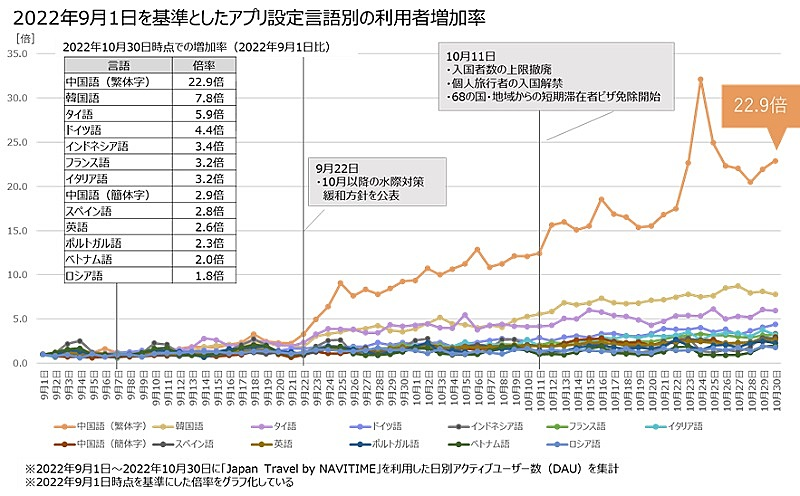

登錄


登錄
海擇短評 Haize Comment:
近期日本導航公司Navitime Japan,根據專為訪日外國旅客設計的內容導覽APP“Japan Travel by NAVITIME”的使用情況,結合用戶國籍和興趣點(POI, point of interest)相關數據給出分析報告。
分析報告給了一個有趣的數據,披露使用量增幅最高的是繁體中文用戶,將10月30日與9月1日對比,增幅達22.9倍;其次為韓泰用戶,韓語用戶增幅7.8倍,泰語用戶增幅5.9倍。而這數據與同期日本JNTO的入境數據衝突,JNTO顯示10月訪日外國旅客人數以韓國最高,達12.29萬人次;台灣並非最高,僅為3.50萬人次,而泰國為3.41萬人次。
Navitime與JNTO數據的差異,固然可能來自從旅遊靈感啟發到出行的滯後,我們推估更高的可能性是,在拉新獲客上,Navitime的新增台灣用戶比韓國用戶更多,才會有這樣的調查結果;但多多少也難以判定,因為Navitime沒公告絕對值,只公告了相對值。
其實我們感覺這篇新聞更像是Navitime的廣編稿,近期日本電商與旅行相關公司,紛紛把台灣用戶視為國際化的第一步,後疫情的新戰國時代已經開打。
----------
Recently, a Japanese navigation company Navitime Japan releases an analysis report, basing on the use of the content guide app "Japan Travel by NAVITIME" specially designed for foreign tourists visiting Japan, combining with related data of user nationality and POI (point of interest).
The analysis report gave an interesting data, revealing that the number of traditional Chinese users reaches the highest growth rate . Comparing October 30th with September 1st, the growth of traditional Chinese users reached 22.9 times; followed by Korean, Thai users, Korean users increased by 7.8 times, and Thai users increased by 5.9 times. This data conflicts with the inbound data of JNTO during the same period. JNTO shows that South Korea contributes the most foreign tourists visiting Japan in October, reaching 122,900; Taiwan is not the highest, only 35,000, while Thailand contributes 34,100.
The data difference between Navitime and JNTO may come from the lag from travel inspiration to departure. We estimate that it is more likely that Navitime attracted more new Taiwanese users than South Korean users, resulting in such survey results; but it is bit hard to say, because Navitime did not announce the absolute value, but only the relative value.
In fact, we feel that this news is more like Navitime’s advertorial. Recently, Japanese e-commerce and travel-related companies view Taiwanese users as the first step in internationalization. The post-pandemic new Warring States era has begun.
----------
최근 일본 내비게이션 회사 'Navitime Japan'은 외국인 관광객을 위한 콘텐츠 가이드 앱인 'Japan Travel by NAVITIME' 사용 현황을 기반으로 사용자 국적, 관심지점(POI, point of interest) 등 관련 데이터를 결합한 분석 보고서를 발표했다.
분석 보고서는 한 흥미로운 데이터를 제공했다. 중국어 정체자 사용자의 증가율이 가장 높은 것으로 나타났다. 10월 30일과 9월 1일에 비해 중국어 정체자 사용자는 22.9배 증가했다. 이어 한국어, 태국어 순이었다. 한국어 사용자는 7.8배, 태국어 사용자는 5.9배 증가했다. 이 데이터는 같은 기간 일본정부관광국(JNTO)의 입국 데이터와 충돌했다. JNTO에 따르면 10월 한국은 방일 외국인 관광객이 12만 2900명으로 가장 많았다. 대만은 최고가 아니라 3만 5000명에 불과하다. 태국은 3만 4100명이다.
Navitime과 JNTO의 데이터 차이는 여행 아이디어 생성에서 실제 여행으로의 지연에서 비롯 될 수 있다. 우리는 Navitime이 새로운 고객을 확보하는 데 있어서 대만의 새로운 사용자가 한국 사용자보다 많기 때문에 이러한 조사 결과를 초래했을 가능성이 더 높다고 추정한다. 그러나 이 역시 말하기 어렵다. Navitime이 절대치를 발표하지 않고 상대치만 발표했기 때문이다.
사실 우리는 이 뉴스가 Navitime의 광고 소프트 텍스트에 더 가깝다고 생각한다. 최근 일본 전자상거래와 관광 관련 기업들은 대만 사용자를 국제화의 첫걸음으로 보고 있다. 대유행병 이후의 새로운 전국시대는 이미 시작되었다.

文章鏈接 Hyperlink:https://www.travelvoice.jp/20221121-152428
資料來源 Resource:TravelVoice
標籤 Label:Navitime Japan tourism post-pandemic